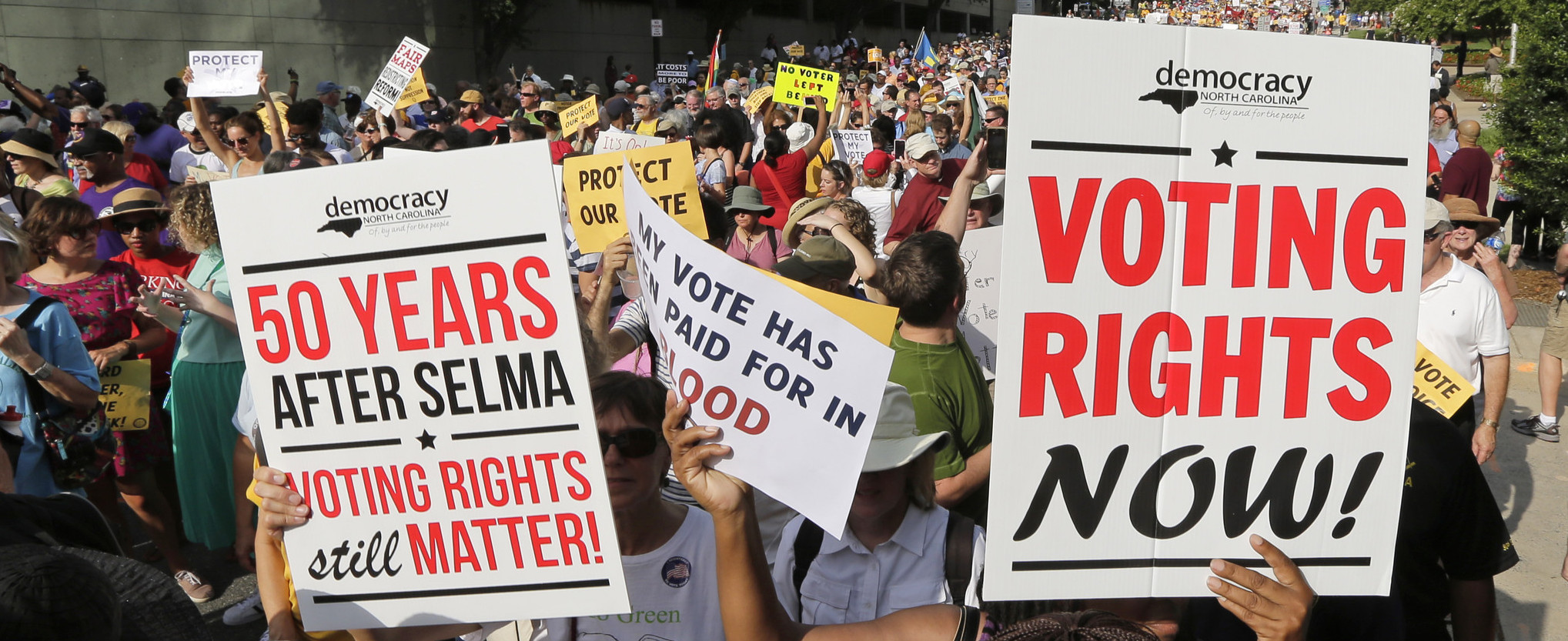Voter Suppression, Then and Now
A demonstration supporting voting rights (Image)
The United States, founded on the democratic principle of free and fair elections, has a longstanding history of voter suppression. Though one may assume that the days of Jim Crow are gone, a number of regulations currently before courts and lawmakers are once again threatening to make it more difficult for certain segments of the population to vote.
In 1776, just after the signing of the Declaration of Independence, only individuals who owned land were granted the right to vote. This qualifier alienated a huge segment of the population, and white, male, Protestant men over the age of 21 made up virtually the entire voting base. In fact, in the election of George Washington, only 6% of the American population could vote. It was not until 1856 when the last state (North Carolina) removed property ownership as a prerequisite for voting.
When the Fourteenth Amendment passed, granting citizenship to former slaves, states still took covert and explicit steps to ensure that non-whites could not vote. Blacks attempting to vote would be asked to pay poll taxes, take exceptionally difficult literacy tests, and fulfill requirements of the Grandfather Clause to be eligible to vote, all of which were specifically designed to disallow blacks from voting.
Though states no longer require literacy tests to be eligible to vote, regulations that seem eerily similar to those of the 19th and 20th centuries are resurfacing in states all across the country.
Over the summer, the Supreme Court upheld Ohio’s system for removing voters from the registry for failing to vote. If an Ohio citizen fails to vote over a certain period of time, he or she will be automatically removed from the state’s voter registry and will have to re-register in order to vote again.
Further south, Republican gubernatorial candidate and current Secretary of State of Georgia, Brian Kemp, has enacted his own method of ”voter roll maintenance.” There, citizens who report that their address has changed, fail to vote in three consecutive years, or have a piece of official mail returned are in danger of losing their voting registration. This practice has cancelled the registrations of 1.4 million Georgia voters since 2012. Such practices by Ohio and Georgia, along with a number of other states, may violate the 2002 bipartisan Help America Vote Act.
Georgia Secretary of State and gubernatorial candidate Brian Kemp (Image)
Earlier this month, the Supreme Court upheld a regulation that will disenfranchise Native Americans living in North Dakota. The regulation requires that voters provide proof of their physical address in order to be able to vote. While this regulation may seem mundane, it has serious consequences for the state’s Native American population, many of which use a P.O. box to receive mail because the postal service does not deliver to the remote areas that they occupy. Thus, citizens using a P.O. box to receive mail may not have a utility bill or a driver’s license with a physical address, which would prevent them from voting.
According to the Pew Research Center, 35% of registered voters that did not go to the polls for the 2014 midterms said that their work or school schedule prevented them from voting. 27 states do not require employers to provide paid time off to vote. The standard that voters must have a photo I.D. to vote unequally disadvantages young people, non-whites, and the older generations. Limitations on same-day registration pose further challenges to members of the working class, college students, and individuals to whom transportation is a challenge. 30 states have laws expressly preventing convicted felons from casting votes.
Altogether, the myriad of regulations on voting disproportionately target non-whites, working class individuals, college students, convicted felons, and those experiencing homelessness.
Further, many speculate that such tactics have underlying partisan motives. For one, the vast majority of states that have implemented laws to unenroll voters from registrations and make it more difficult for certain segments of the population to vote do so under Republican control. Additionally, the groups of individuals most often disadvantaged by strict voting regulations - non-whites, working class people, college students, convicted felons, and homeless individuals - all have a tendency to vote for the Democratic party.
Republicans have responded to Democrats’ partisan critiques by expressing concerns about voter fraud. A campaign spokesperson to Secretary Kemp stated that special voting regulations aim to ”protect the integrity of our elections and ensure that only legal citizens cast a ballot.”
Regardless of the motivations behind voter restrictions, such patterns are not new; they date back to the early days of the United States’ founding and have been questioned as to their place in a democracy time and time again.


